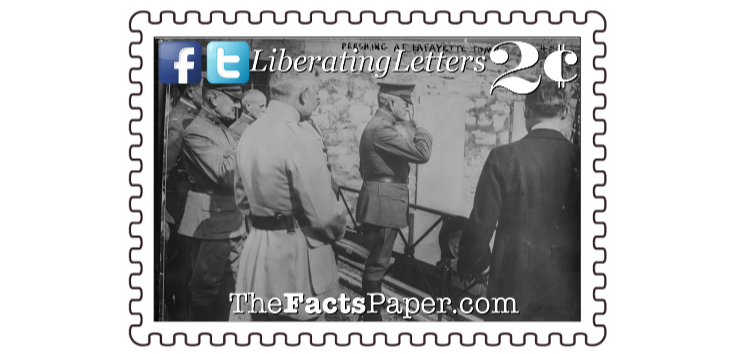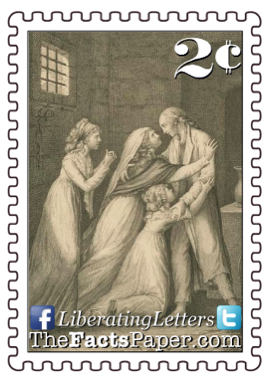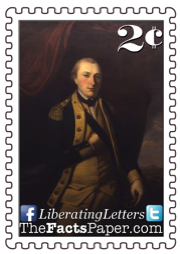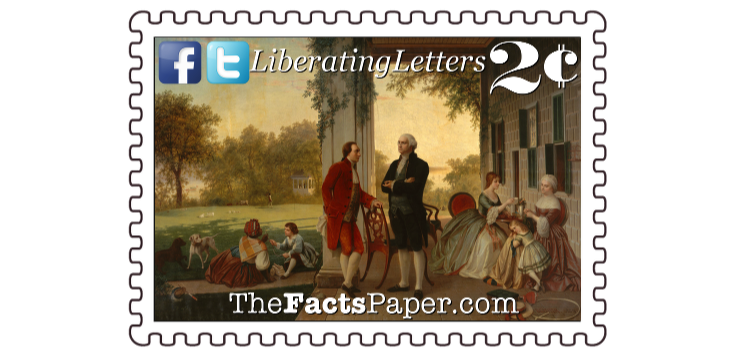Liberty, America united its citizens together in a way no other county had before. Not by race or color or ethnicity or background, but by an idea. Freedom and liberty for all has been the foundation of this country and it is what prompted millions to risk everything to approach our shores and borders. However, today’s post-modern attitude insists that everything this country was build on is evil and must be torn down. Just a little self-study shows a total breakdown of a society only opens the door for a dictatorial tyrant, such as France’s Robespierre and Russia’s Vladimir Lenin. (see Communism’s Rise)
Lafayette was loved and adored not because he wanted to destroy everything, but because he wanted to build something special: true freedom. He realized completely tearing down the old society can be deadly to the new one. This is why he supported a constitutional monarchy and not Robespierre. Yet through it all, he never stopped believing in and fighting for freedom and liberty. It is up to your generation to proclaim, “Lafayette, we are still here,” and be willing to fight to preserve and restore those ideas. It’s the least we can do for those who shed their blood and endured overwhelming hardships to give it to us in the first place.
That’s my 2 cents.
Love,
Mom

Following the Reign of Terror and Robespierre’s beheading, Napoleon Bonaparte secured Lafayette’s release along with other French prisoners. They were sent to the American consul in Hamburg where Lafayette wrote Napoleon a note of gratitude. However, the new French government, the Directorate, refused to let the former General return until he swore allegiance to Napoleon. Unwilling to do so as he believed Napoleon obtained power unconstitutionally, the Directorate responded by confiscating and selling his remaining properties, leaving him penniless. With America now at odds with France, they were unable to accept the Lafayettes, however their son joined them on an aunt’s property in Hamburg, Prussia. (see Reign of Terror) So, for now, the “Hero of Two Worlds” could call neither home.
Eventually, Lafayette made his way back to France where Napoleon allowed him to reclaim some of his properties. Nevertheless, Lafayette continued to reject the ruler. He remained retired and relatively quite, especially following the death of his beloved Adrienne on Christmas Day 1807. However, he received several prominent visitors as well as public admirers, especially Americans, and exchanged many letters, in particular with Jefferson.
Once Napoleon abdicated on June 22, 1815, four days after Waterloo, the monarchy was restored. Despite opposing Napoleon, Lafayette arranged for him to travel to America. However, the British obstructed the plan. Lafayette continued to fight for freedom and liberty from his elected seat in the Chamber of Deputies.
Accompanied by his son, Lafayette made one final trip to America in 1824 at the invitation of President James Monroe and Congress. His visit regenerated Revolutionary War veterans, especially those who served under him, who greeted him in New York upon his arrival on August 15. Lafayette’s visit also inspired the restoration and preservation of Revolutionary artifacts and locations. What intended to be a quiet trip throughout the states turned into celebrations and welcoming parties in every little town they went through while large cities raced to surpass the others.
Not willing to be outdone by New York or Boston, Philadelphia planned a large reception. Therefore, the city decided to restore the Old State House for the event. Because of this, Independence Hall escaped it’s likely future of demolition. (see Let Liberty Ring!) Lafayette also witnessed the end of the highly contentious election of 1824 between John Quincy Adams and Andrew Jackson as the House chose Adams on February 9, 1825. (see History Rhymes Again) That evening, Lafayette witnessed the peaceful handshake between the two men of very opposing views. Something he longed for in France.
While at Bunker Hill, Lafayette collected some soil, which would be sprinkled on his grave. (see Defining The American Spirit) He visited several political officials and Patriot friends, such as Jefferson, James Madison, John Adams and Jackson, as well as Mount Vernon to pay his respects to Washington. To finish his trip, President Adams threw him a 68th birthday party at the White House on September 6.
By the time Lafayette reached home, King Charles X, a former cavalry student of his, had ascended the throne. As another revolution erupted in 1830, Lafayette was again placed at the head of the National Guard. Upon Charles’ abdication on August 2, due to the July Revolution, Lafayette was offered the position of ruler. In true Washington fashion, he refused. (see The Man Who Refused To Be King) Concerned that totally dissolving the monarchy for an American style republic would overwhelm the already fragile France, he supported Louis-Philippe, duc d’Orleans, who lived for a time in America, for the throne.
Lafayette continued to remain active in the government as the king proved to renege on promises and polices. Lafayette fought against dictatorial monarchs and for a constitutional based government until his death on May 20, 1834, at age 76. Buried next to his wife at Picpus Cemetery, per his request, Lafayette’s son scattered the soil from Bunker Hill on his grave. Seeking revenge for Lafayette’s opposition, the king ordered a military funeral which excluded the public, a decision they protested outside the cemetery.
In the states, President Jackson honored Lafayette as well, ordering the same memorial honors awarded to Washington. Congress members donned mourning badges while the two chambers were covered with black cloth for thirty days.
Once the United States entered World War I, many saw it as a chance for America to repay Lafayette. (see The Day America’s Neutrality Sank) The Big Red One arrived in France on June 28, 1917, to enthusiastic crowds waving American flags. Realizing the French were war-weary, General John Pershing marched his troops through Paris, stopping at Lafayette’s tomb. (See The Forgotten General) Pershing’s aide, Colonel Charles E. Stanton, preceded to tell the hero:
“What we have of blood and treasure are yours...In the presence of the illustrious dead, we pledge our hearts and our honor in carrying the war to a successful conclusion...Lafayette, we are here!” (see Duty First)
Working his way through Austria, Lafayette was taken prisoner once his identity was discover. Meanwhile, Adrienne, his wife, was imprisoned in France. Trying to invoke his American citizenship, Lafayette’s position in the French National Guard prevented it. However, the U.S. smuggled his son, Georges Washington, into the states, while Secretary of State Jefferson discovered a way to secure payment to Lafayette for services rendered during the Revolutionary War. Without diplomatic relations with Austria, President Washington refrained from intervening, yet he helped by signing the payment legislation, which sustained the Lafayette’s during their time in prison. Once France released Adrienne, she and their two daughters voluntarily joined Lafayette in captivity on October 15, 1795, where they remained together for two years while Robespierre covered France in blood. (see Reign of Terror)
Back in France, the economy began to collapse, leading to unrest. In efforts to find a solution, the king summoned an Estates General, which convened in 1789. Elected as a noble representative in the Second Estate, Lafayette advocated for equality between the Estates. (see Storming The Bastille) Several other nobles and clergy decided to stand with the commoners, forming the National Assembly. As revenge, loyalists locked the Assembly out of talks. Therefore, they met elsewhere, promising to remain until a constitution was written, known as the “Tennis Court Oath.” Taking pen in hand, Lafayette consulted Jefferson and drafted the Declaration of the Rights of Man and of the Citizen, which he presented to the Assembly on July 11. Three days letter the Bastille was stormed. (see Ratifying Liberty)
Accepting the command of the National Guard of France, General Lafayette was charged with guarding and protecting the royal family at Tuileries Palace in Paris. Desiring a constitutional monarchy, he soon found himself in the uncomfortable position between the loyalists, wanting to completely restore the monarchy, and the revolutionaries, wanting to completely destroy it. On the Bastille storming anniversary, Lafayette led an oath to be loyal to the nation and the king in front of the Fête de la Fédération (federation festival) in hopes to unite.
Needing more prison space, authorities decided to restore dungeons at the Château de Vincennes. However, the decision only escalated rumors of a royal escape as many believed it was only to cover up an underground passageway between it and Tuileries Palace. Therefore, 12,000 Jacobin’s, a radical revolutionary group, intending on destroying the prison once and for all, began a riot at the Château early February 28, 1791. During the mayhem, several attempts were made on Lafayette’s life while he dispersed the crowd.
Meanwhile, in Paris, an armed possible assassin made his way into Tuileries Palace, but was removed without incident. In response, hundreds of nobles armed with primarily daggers gathered at the palace to defend their king. Misreading their intensions, guards assumed it was a counter-revolution. Lafayette raced back to Paris, yet the aristocrats would not back down until the king validated Lafayette’s orders. Known as the Day of Daggers, roughly 400 loyalists were disarmed by Lafayette, increasing his popularity with the citizens.
Political groups spun and stretched the event for propaganda purposes. Therefore, when the royal family actually did flee on June 20, 1791, only to be arrested in Varennes, the country exploded. Robespierre, a leader of the Jacobins, used the king’s actions to attack Lafayette, painting him as a loyalist and turning public opinion sharply against him. Moreover, the desire to dissolve the monarchy grew. Therefore, on July 17, a crowd of 10,000 assembled in the Champ de Mars to collect signatures demanding the king’s abdication. While trying to disperse the crowd, guards opened fire, resulting in 50 deaths and dozens of wounded. Lafayette and other moderates became casualties of the Champ de Mars Massacre as radicals quickly destroyed what was left of their reputations.
Once the Assembly finalized and approved a constitution in September, Lafayette resigned from the National Guard, as his influence declined while Robespierre’s power increased. With unopposed power in the Assembly, the resistance declared war on Austria on April 20, 1792. Lafayette denounced the Jacobins and other radical groups, delivering a contentious and strongly critical speech that summer. Robespierre responded by calling him a traitor. A month later, as the radicals stormed the Tuileries and captured the royal family, an arrest warrant was issued for Lafayette, forcing him to flee. (see Storming The Bastille)

August 2, 2018
Dear Liberty,
At age 19, the Marquis de Lafayette left the comforts of his home, not to mention his young pregnant wife and daughter, to fight for liberty for another country. However, his efforts to do the same in his own country led to imprisonment, poverty, and unpopularity. Lafayette spent four years fighting for America’s freedom, yet he would spend the rest of his life trying to secure France’s liberty. (see Hero Of Two Worlds - The American Years)
After returning to France in 1781 as a “Hero of Two Worlds,” Lafayette helped negotiate peace between Britain and the United States with the signing of the Treaty of Paris on September 3, 1783, finally ending the American Revolution. Lafayette also fought to end France’s slave trade as well as establish equal rights for free blacks. It was an issue Thomas Jefferson tried to address in America, but was prevented from doing so. (see Inalienable Rights and The Forgotten Midnight Ride)
In 1784, Lafayette returned to America, traveling to every state, as well as Mount Vernon to see his mentor and dear friend General George Washington. He received several gifts from cities and states, such as paintings and busts. Lafayette also reunited with James Armistead, a slave who fought under him and who was crucial in winning Yorktown. (see The Forgotten Hero) Several states made Lafayette and his male heirs citizens while Maryland declared them “natural born citizens”. Following the adoption of the Constitution, their state citizenship status transferred to United States. (see Constitution Day)
HERO OF TWO WORLDS:
THE FRENCH YEARS




